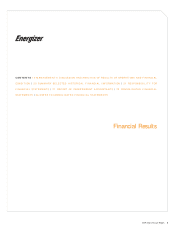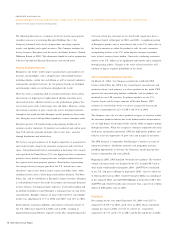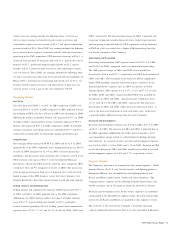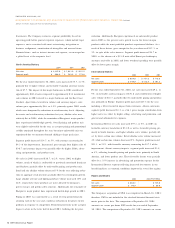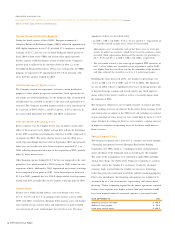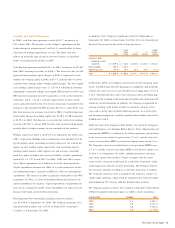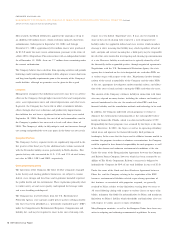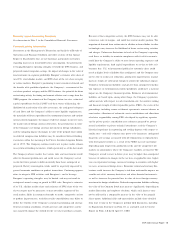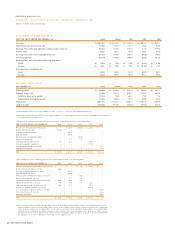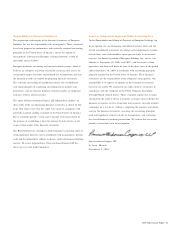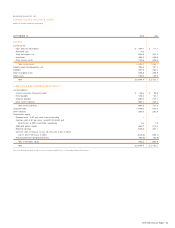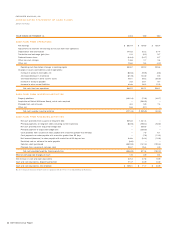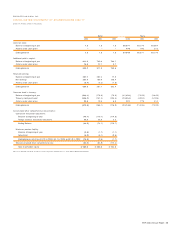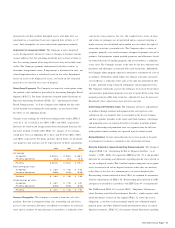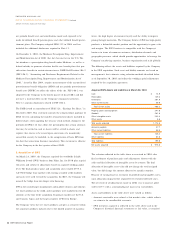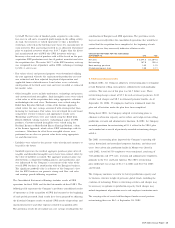Energizer 2004 Annual Report Download - page 21
Download and view the complete annual report
Please find page 21 of the 2004 Energizer annual report below. You can navigate through the pages in the report by either clicking on the pages listed below, or by using the keyword search tool below to find specific information within the annual report.
ENR 2004 Annual Report 19
Recently Issued Accounting Standards
See discussion in Note 2 to the Consolidated Financial Statements.
Forward-Looking Information
Statements in the Management’s Discussion and Analysis of Results of
Operations and Financial Condition and other sections of this Annual
Report to Shareholders that are not historical, particularly statements
regarding increases in household battery consumption, the potential for
leveraging Energizer’s operating strengths to benefit the SWS business, and
projected annual integration savings, the impact of changes in the value of
local currencies on segment profitability, Energizer’s estimates of its share of
total U.S. retail alkaline market, and SWS share of the wet shave category
in various markets, Energizer’s positioning to meet consumer demand and
the benefits of its portfolio of products, the Company’s assessment of the
wet shave products category and the SWS business, the potential for future
restructuring activity, the timing and amount of future cost savings from the
VERO program, the estimates of the Company’s future tax rates, estimated
capital expenditures for fiscal 2005 and their source of financing, the
likelihood of acceleration of its debt covenants, the anticipated adequacy
of cash flows and the Company’s ability to meet liquidity requirements,
the materiality of future expenditures for environmental matters and environ-
mental control equipment, the impact of adverse changes in interest rates,
the market risk of foreign currency derivatives, the potential loss in value
of the Company’s net foreign currency investment in foreign subsidiaries,
and the mitigating impact of changes in value of the prepaid share option
on deferred compensation liabilities may be considered forward-looking
statements within the meaning of the Private Securities Litigation Reform
Act of 1995. The Company cautions readers not to place undue reliance
on any forward-looking statements, which speak only as of the date made.
The Company advises readers that various risks and uncertainties could
affect its financial performance and could cause the Company’s actual
results for future periods to differ materially from those anticipated or
projected. Battery consumption trends could be negatively impacted by
general economic conditions or product innovations. Continuing opportu-
nities to integrate SWS activities with Energizer’s, and to leverage
Energizer’s operating strengths, may be limited, and may not result in
anticipated annual savings or growth in SWS sales. Energizer’s estimates
of its U.S. alkaline market share and estimates of SWS share of the wet
shave category may be inaccurate, or may not reflect segments of the
retail market. Shifts in consumer demands or needs, competitive activity
or product improvements, or further retailer consolidations may dilute or
defeat the benefits of the Company’s consumer positioning and strategy.
General economic conditions, retailer pressure and competitive activity
may negatively impact the outlook for the wet shave products category.
Because of that competitive activity, the SWS business may not be able
to increase sales or margins, and could lose current market position. The
migration of demand from carbon zinc to alkaline or from alkaline to other
technologies may increase the likelihood of future restructuring activities
and charges. Unforeseen fluctuations in levels of the Company’s operating
cash flows, or inability to maintain compliance with its debt covenants,
could limit the Company’s ability to meet future operating expenses and
liquidity requirements, fund capital expenditures or service its debt as it
becomes due. U.S. or international political or economic crises could
result in higher levels of inflation than anticipated, and the Company may
not be able to realize cost reductions, productivity improvements or price
increases which are substantial enough to counter the inflationary impact.
Unknown environmental liabilities and greater than anticipated remedia-
tion expenses or environmental control expenditures could have a material
impact on the Company’s financial position. Estimates of environmental
liabilities are based upon, among other things, the Company’s payments
and/or accruals with respect to each remediation site; the number, ranking
and financial strength of other responsible parties (PRPs), the status of the
proceedings, including various settlement agreements, consent decrees or
court orders; allocations of volumetric waste contributions and allocations
of relative responsibility among PRPs developed by regulatory agencies
and by private parties; remediation cost estimates prepared by govern-
mental authorities or private technical consultants; and the Company’s
historical experience in negotiating and settling disputes with respect to
similar sites – and such estimates may prove to be inaccurate. Anticipated
long-term cost savings associated with job eliminations or replacements
with lower-priced workers as a result of the VERO may not materialize
depending upon longer-term production needs and the competitive job
markets in communities where the Company’s facilities are located. The
Company’s overall tax rate in future years may be higher than anticipated
because of unforeseen changes in the tax laws or applicable rates, higher
taxes on repatriated earnings, increased earnings in countries with higher
tax rates, or increased foreign losses. Economic turmoil and currency fluc-
tuations could increase the Company’s risk from unfavorable impacts on
variable-rate debt, currency derivatives and other financial instruments,
as well as increase the potential loss in value of its net foreign currency
investment in foreign subsidiaries. Deferred compensation liabilities reflecting
the value of the Common Stock may increase significantly, depending on
market fluctuation and employee elections, which such increase may
not be reflected in a comparable increase in the value of the prepaid
share option. Additional risks and uncertainties include those detailed
from time to time in the Company’s publicly filed documents, including
its Registration Statement on Form 10, as amended, and its Current
Report on Form 8-K dated April 25, 2000.


